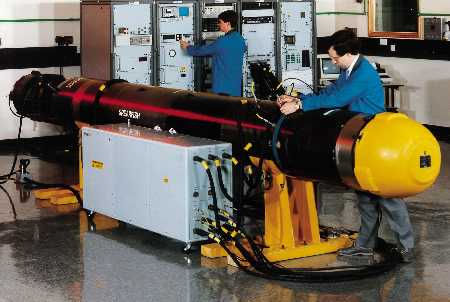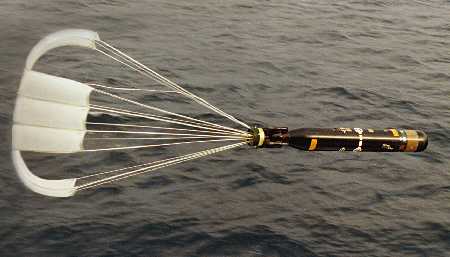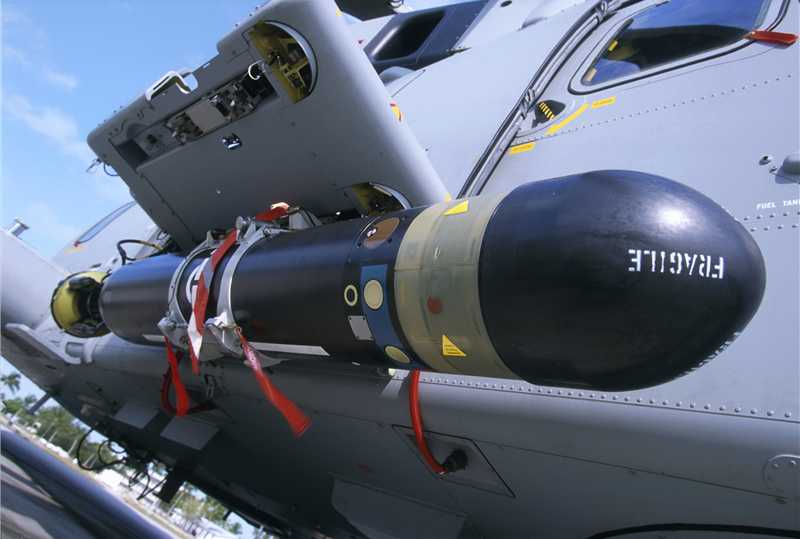| Ship Class Used On | Aircraft and Surface Ships |
|---|---|
| Date Of Design | Dealer: 1946
Dealer B: About 1950 |
| Date In Service | 1954 |
| Weight | N/A |
| Overall Length | N/A |
| Negative Buoyancy | N/A |
| Explosive Charge | N/A |
| Range / Speed | N/A |
| Power | Battery |
The original Dealer torpedo had no control surfaces, being steered by two propellers that varied in speed. Depth keeping was achieved by moving the battery back and forth. Dealer did not see service use, but its successor, Mark 30 Mod 0 (Dealer B), an eight-fin passive homer using conventional propellers, was issued starting in June 1954. Considered very successful with approximately 1,200 being built and it served in both the RN and RAF until 1970. The Mark 30 Mod 1 had several improvements but this program was canceled in 1955 in favor of purchasing Mark 43 Mod 3 torpedoes from the USA.
There is no information available on Mark 13 to Mark 19.
| Ship Class Used On | Submarines |
|---|---|
| Date Of Design | About 1925 |
| Date In Service | 1927 |
| Weight | 3,452 lbs. (1,566 kg) |
| Overall Length | 259 in (6.579 m) |
| Explosive Charge | 805 lbs. (365 kg) Torpex |
| Range / Speed | 5,000 yards (4,570 m) / 45.5 knots
7,000 yards (6,400 m) / 41 knots |
| Power | Burner-cycle |
The Mark VIII was the first burner-cycle torpedo in service. Although the original design dates from the 1920s, those manufactured during and after World War II were to a much-modified design. The Mark 8** was the British torpedo most used during World War II and was supplied to destroyers and MTBs as well as submarines. This torpedo was still in front-line use as late as 1982 during the Falklands War when the submarine HMS Conqueror fired three Mod 4 torpedoes at the Argentine cruiser General Belgrano. Two of these hit the cruiser, sinking her with a heavy loss of life. This was the first sinking of an enemy warship by a nuclear submarine of any nation. The Mark 8 was finally removed from British service in the early 1990s but stayed in use for a longer period in the navies of other nations that Britain has supplied with submarine weapons.
| Ship Class Used On | Submarines |
|---|---|
| Date Of Design | about 1952 |
| Date In Service | see Notes |
| Weight | 3,452 lbs. (1,566 kg) |
| Overall Length | 254.5 in (6.464 m) |
| Explosive Charge | about 750 lbs. (340 kg) Torpex |
| Range / Speed | N/A |
| Power | HTP (High Test Peroxide - hydrogen-peroxide) |
This design was developed from German and USA hydrogen-peroxide torpedoes of World War II, but generally was a Mark 8 torpedo body modified to use HTP. Renamed "Fancy" sometime during development. Hydrogen-peroxide is a notoriously unstable fuel, as was shown when the "S" class submarine HMS Sidon loaded two Mark 12 torpedoes on 16 June 1955 for a test firing planned for later that day. Sidon was very badly damaged when one of these torpedoes exploded in her No. 3 torpedo tube, killing 13 men. Sidon was raised a few days later, declared CTL and was eventually scuttled as a sonar target. Another Mark 12 torpedo suffered an explosive failure on the Arrochar test range during the same year. The development program was eventually canceled and all of these torpedoes were withdrawn from service in 1959. An analysis of the failures showed that the basic problem was the decision to reuse the Mark 8 torpedo body. Hydrogen-peroxide in contact with materials other than synthetic rubber and porcelain is corrosive and explosive. The British shared their design studies and failure analysis with the Swedish Navy who profited from this knowledge to make their reliable and high-speed Tp 61 torpedo. This implies that had the British continued HTP development they might have had a high-speed torpedo much sooner.
| Ship Class Used On | Surface ships and submarines |
|---|---|
| Date Of Design | about 1950 |
| Date In Service | 1955 |
| Weight | 1,810 lbs. (821 kg) |
| Overall Length | 254.5 in (6.464 m) |
| Explosive Charge | 196 lbs. (89 kg) |
| Range / Speed | 20 E and 20 S: 12,000 yards (11,000 m) / 20 knots
20 C: 7,000 yards (6,600 m) / 23 knots |
| Power | Battery |
Passive-homer. 20 E was for escorts while 20 S was the submarine version. The surface version was abandoned very shortly after service introduction because its preset attack data system proved unreliable. The New Zealand frigates Taranaki and Otango carried it for some time after it was withdrawn from British ships. The Mark 20 C was another submarine version of the early 1960s. Replaced by Tigerfish in the 1980s.
A high-speed, deep-running, post-war torpedo program which saw protracted development and was eventually canceled.
A wire-guided version of the Mark 20, this was unsuccessful and did not enter service, although VSEL produced a private-venture version in 1970.
A modified Mark 20 with a wire-guidance system between the battery compartment and the afterbody. Development started in the 1950s with the prototype being tested in 1955 but was not issued for service use until 1966 and did not become fully operational until 1971. At that time, it was obsolescent and too slow to catch modern submarines, but was issued as an interim torpedo pending the appearance of the Mark 24. Total weight of 2,000 lbs. (907 kg). Range was reportedly 8,750 yards (8,000 m) at 28 knots.
| Ship Class Used On | Submarines |
|---|---|
| Date Of Design | 1967 for original proposal |
| Date In Service
(see text) |
Mod 0: 1980
Mod 1: 1979 Mod 2: 1986 |
| Weight | 3,420 lbs. (1,551 kg) |
| Overall Length | 254.5 in (6.464 m) |
| Explosive Charge | 750 lbs. (340 kg) Torpex |
| Range / Speed | 23,000 yards (21,000 m) / 35 knots
about 30,000 yards (27,400 m) / 24 knots |
| Power | Twin silver-zinc batteries |
Mod 0 was an ASW torpedo. When this entered service trials in 1973, the reliability was very poor, about 40% on average functioning as intended. This torpedo depends heavily on data provided by the firing submarine, but the torpedo tended to dip and break the guidance wires during launch. Mod 0 failed provisional fleet acceptance trials in 1979 but was issued to the fleet starting in 1980. Mod 1 had an anti-ship seeker, but experienced problems with the shipboard tactical-data system and with actual torpedo control. During this time, the Royal Navy Torpedo Factory (RNTF) was closed and production passed to Plessey. The redesigned Mod 1 version passed trials in 1978 and was issued to the fleet the following year.
However, in a test performed in 1982 immediately after the Falklands War, two out of five Mod 1 torpedoes fired at a target hulk failed to function because of bad batteries and none of the others even hit the target. This unreliability was well known in the Fleet, which is why ancient Mark 8 torpedoes were used to sink the Argentine cruiser General Belgrano.
A Consolidation Program (i.e., "get well") undertaken by Marconi during the mid-1980s improved the reliability to 80%, which was considered satisfactory. Torpedoes built to the new standards were designated as Mod 2, and all 600 existing Mark 24 torpedoes were modified to this standard by 1987. In 1990 Cardoen of Chile obtained a license to manufacture Tigerfish for the Brazilian, Chilean and Venezuelan navies.
The Royal Navy has removed all Tigerfish from service as of February 2004.
| Ship Class Used On | Submarines |
|---|---|
| Date Of Design
(see text) |
1978 |
| Date In Service | 1994 |
| Weight | 4,077 lbs. (1,850 kg) |
| Overall Length | about 234 in (5.950 m) |
| Explosive Charge | 661 lbs. (300 kg) |
| Range / Speed | 1981 version: About 23,000 yards (21,000 m) / 60+ knots
1994 version: Range unknown / 80+ knots |
| Power | HAP-Otto Fuel (pump-jet propulsor, turbine engine)
(HAP stands for hydrogen ammonium perchlorate) |

Spearfish was the result of feasibility studies conducted in 1977-1979 which led up to Naval Staff Target (later requirement) 7525. Marconi produced a design to this requirement in 1978-1979 based upon co-producing it with the Stingray torpedo and sharing components between the two. This design never reached the pre-production stage as the requirements were constantly changed by MOD and production was further delayed by the decision to reopen the bidding process in 1989 to include Dowty and British Aerospace proposals. Marconi produced about 100 pre-production torpedoes during the late 1980s but it is not known how much these resembled the final design. In mid-1990, MOD suspended orders in hopes that Spearfish would be adopted as a standard European weapon. This torpedo is wire-guided with with both active and passive acoustic homing seekers. Speed is reportedly significantly reduced at great depths because the pump-jet design cannot handle the high backpressures.
These torpedoes proved unreliable in early service use. A series of Consolidation Programs (i.e., "get well") by Marconi between 1990 and 1994 improved the reliability to a "satisfactory level," probably greater than 80%. These programs lead to many detailed changes being implemented to the torpedo's design and included the introduction of static testing and pre-conditioning during their manufacture along with environmental screening of the completed torpedoes to screen for faulty components.
The guidewires for this torpedo are were originally made from a copper-cadmium alloy. As cadmium is environmentally unfriendly, a program to change over to a fiber optic system was started in 2004.
| Ship Class Used On | Aircraft / ASW Helicopters |
|---|---|
| Date Of Design | Mod 0: 1977
Mod 1: 2002 |
| Date In Service | Officially in 1986, but the HMS Antelope reportedly had four onboard when she
was sunk during the Falklands War in 1982.
Mod 1 was scheduled for operational service in 2006. |
| Weight | 588.5 lbs. (267 kg) |
| Overall Length | 102.4 in (2.600 m) |
| Explosive Charge | 99 lbs. (45 kg) Shaped Charge Torpex (it was been proposed that this be replaced by PBX-104, a plastic explosive, but this plan has apparently been abandoned) |
| Range / Speed | 8,750 yards (8,000 m) / 45 knots |
| Power | Magnesium/silver-chloride seawater battery (Pump-jet) |


Mod 0 is a homing torpedo using active acoustic, dual-frequency FM pulses and preformed beams. Purchased in preference to the USN Mark 50 lightweight torpedo. In 1981 the design team for the Stingray torpedo claimed depth performance equal to a Soviet Alfa-class submarine, which would equate to about 800 m.
BAE Systems was awarded a £441m contract in 2003 to supply the Royal Navy and Royal Air Force with the next generation of lightweight torpedo, the Mod 1. Sting Ray Mod 1 is intended to have an enhanced capability against small conventional submarines and an improved shallow-water performance. Mod 1 will use a new digital homing system to enhance the weapon's acoustic and tactical performance and also includes a shaped-charge Insensitive Munitions warhead. The torpedo is to incorporate new technologies in order to greatly reduce the maintenance requirements and allow easy upgrades to its software.
"The Naval Institute Guide to World Naval Weapon Systems 1991/92" by Norman Friedman
"From Fancy to Stingray: British Torpedoes since 1945" article by Antony Preston in "Warships Volume V"
---
Ministry of Defence Press Releases
BAE Systems Press Releases
29 January 2010 - Added picture of Stingray Torpedo on helicopter
27 December 2010 - Updated Mark 8 to include Mod 4 and other information
28 December 2013 - Added photograph of HMS Resolution
07 October 2019 - Converted to HTML 5 format

